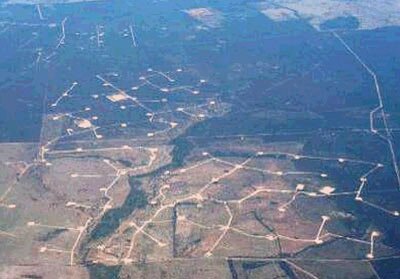In September last year, the coal seam gas (CSG) industry launched a multimillion dollar advertising campaign called We want CSG. It is sponsored by the Australian Petroleum Production and Exploration Association (APPEA) — the peak national body for oil and gas exploration — which represents companies such as Shell, Santos, Origin Energy, British Gas, AGL, PetroChina and ConocoPhillips.
This campaign kicked off in the context of broad public opposition to the industry: an August 2011 Galaxy poll found that 68% of Australians support a moratorium on CSG mining until more is known about the health and environmental impacts.
In an APPEA media release, chief operating officer for eastern Australia, Rick Wilkinson, said the “We Want CSG” campaign was meant to counter “the loudest voices in Australia’s energy debate” by giving “the facts — not myths — about CSG, the industry’s operations, and the critical role gas can play in reducing greenhouse gas emissions”.
Some of these “facts” — put forward in the campaign’s new television ads — are examined below.
Claim: “This is a coal seam gas well. It takes up less land than half a tennis court.”

The impact of unconventional gas well heads on the landscape
The problem with this claim is what the ad fails to mention: that CSG mining takes far more than a well.
A CSG production field has a large above-ground footprint. It needs a wellhead every 300 to 900 metres. Each well requires at least one, and up to four hectares, of cleared land for the drilling pad, pumps, generators, compressors, vehicles and a storage pond or tank to hold waste water.
Further land clearing may take place for the construction of gas pipelines, firebreaks and access roads capable of handling heavy vehicles and equipment.
Half a tennis court might sound harmless, but CSG production means industrial development. None of the ads inform the public of this fact.
Claim: “Without CSG NSW will have to rely heavily on black coal for its electricity supply.”
The source APPEA give for this “fact” is The Australian newspaper on January 9 this year.
Astoundingly, the article simply includes a quote from an unnamed spokesperson for Santos — a CSG mining and exploration company — making this claim. Of course, that someone in the CSG industry said something to a newspaper does not make it a “fact”.
More importantly, in this case, it’s untrue. Failure to develop the CSG industry does not force the use of black coal to generate electricity. Renewable energy could replace the development of CSG and new and existing coal-fired power.
Research by Beyond Zero Emissions (BZE) and the University of Melbourne Energy Research Institute shows Australia could meet all its electricity needs from 100% renewable sources within a decade, using commercially available technologies.
Claim: “Wholesale electricity prices will be 11% higher without more CSG in NSW.”
This statement comes from an APPEA-funded report by ACIL Tasman. All of the scenarios it compares assume that electricity generation in NSW will mostly come from coal or gas in 2030.
It does not model electricity prices under a large-scale transition to renewables. Indeed, the baseline scenario used suggests that renewables will account for only 6% of NSW energy output in 2030. This is despite the fact that in 2010 renewables accounted for more than 19% of global energy production.
The current overall cost per unit of energy produced by wind power is similar to the cost for new coal and natural gas installations, says the US government’s Energy Information Administration. Also, although renewables are more expensive to build, solar, wind and hydro energy have no ongoing fuel costs.
Claim: “CSG could provide millions of dollars each year in royalties to NSW.”
“Could” is the operative weasel word here. As it stands, the CSG industry in NSW enjoys a royalty holiday for the first five years of production.
Claim: “The natural gas extracted is up to 70% cleaner than coal for electricity.”
 The reference for this claim is a study by WorleyParsons, also commissioned by APPEA.
The reference for this claim is a study by WorleyParsons, also commissioned by APPEA.
What the ad fails to mention is that this same study looked at a range of scenarios. WorleyParsons also found that when CSG is burnt in old gas plants — common in Australia — emissions are up to 44% higher than burning coal in new coal plants.
The research has also been widely criticised, particularly as the study models best-practice scenarios rather than real operating practice, and because most of the data is industry funded, old or based on different extraction practices.
Also, it rules out the possibility of large or ongoing methane leaks from CSG wells and does not include Australian data on escaped methane from CSG.
But CSG extraction results in big fugitive methane emissions. Methane is a highly flammable and potent greenhouse gas that warms the atmosphere at 105 times the rate of CO2, over a 20-year period. These emissions come from leaking pipelines, wellheads and processing plants. It also escapes from mining waste water and underground systems.
Researchers from the US National Oceanic and Atmospheric Administration said air sampling of gas fields in Colorado showed leakage rates of 4% on average, and up to 7.7%. This is far greater than the rates assumed by WorleyParsons, the CSG industry and the Australian government.
A 2011 study by Tom Wigley of the Center for Atmospheric Research concluded: “Unless leakage rates for new methane can be kept below 2%, substituting gas for coal is not an effective means for reducing the magnitude of future climate change.”
A BZE study into lifecycle emissions from gas sources in Australia suggests that a switch to CSG may do nothing or be counterproductive for cutting greenhouse gas emissions.
BZE executive director Matthew Wright told the October 8, 2011, Sydney Morning Herald that CSG — after conversion to liquefied natural gas — is likely to prove, at best, slightly cleaner than new coal, and possibly worse.
Paul from Stop CSG Sydney has created a great reply to the CSG Industry Ad… check it out: